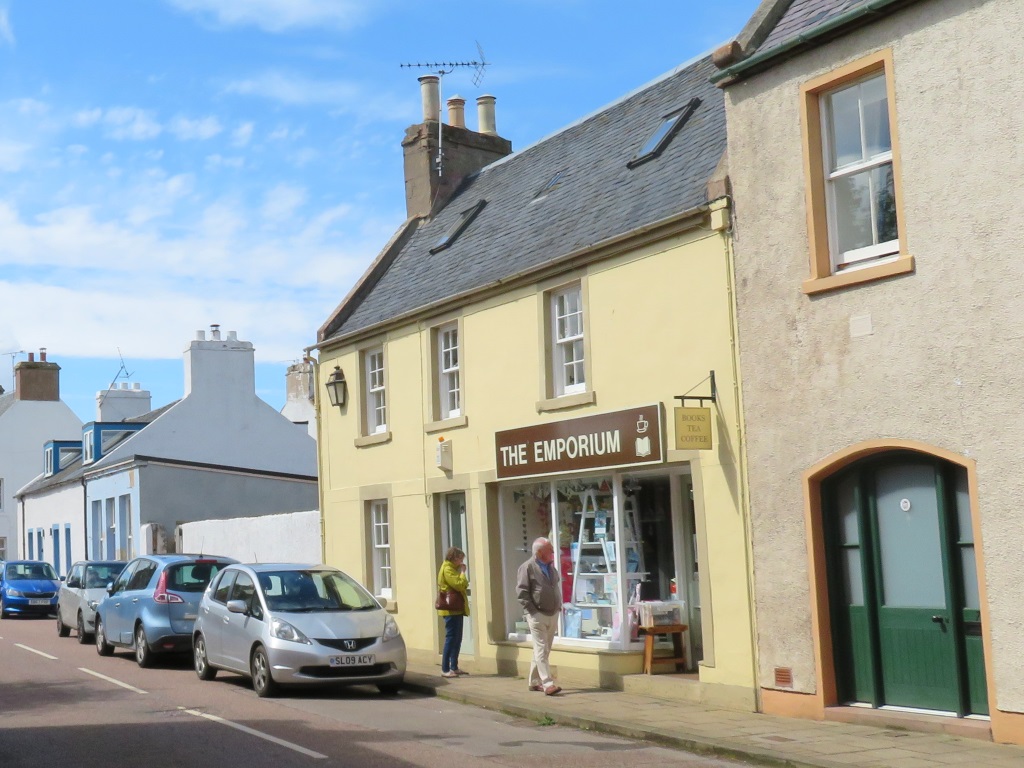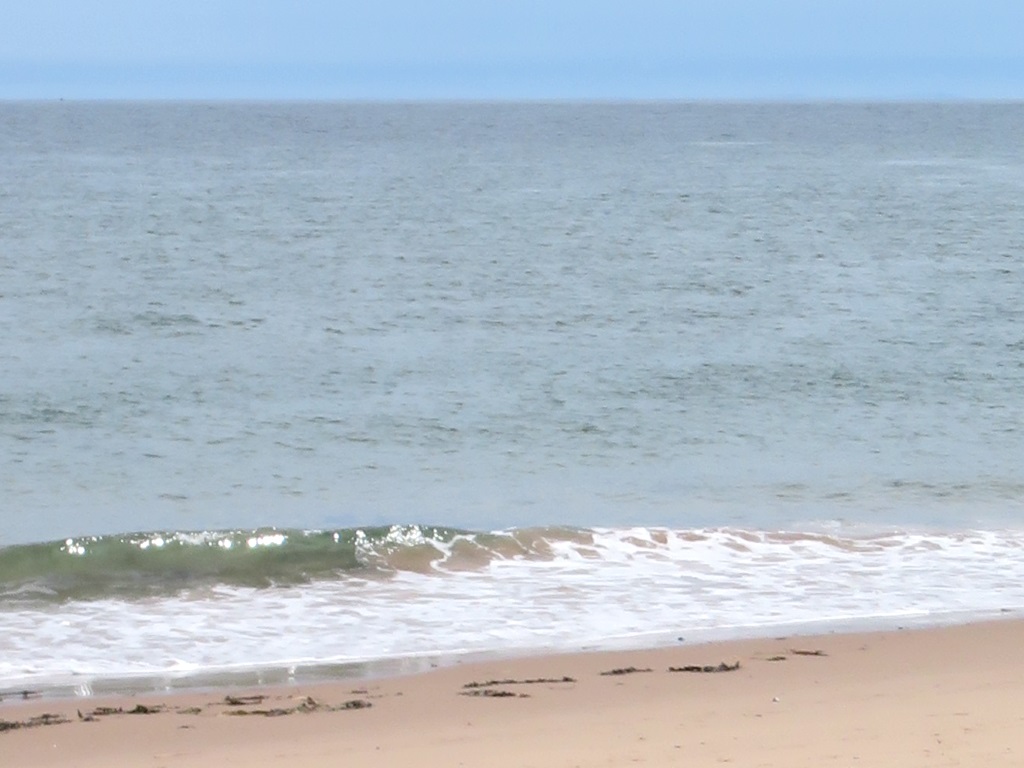It's hard to believe that you can't believe that this pair of intrepid travellers have never been this far north before and it's also a first for a place that you'll hear on the Shipping Forecast.
Strictly speaking, the Isle of Portland isn't quite so that's close but no sea-haar.
The offshore industry is a jarring sight and Siemen™s, no less, assemble wind turbines over the water at a place called Nigg.

The German Blight is a recent addition to the long-established repair yards for the oil platforms that are either waiting to get in or get floated out towards the Faeroes, possibly?
They're not the only things to disappear over the horizon. The Highland Clearances saw thousands of tenant farmers and their families displaced and emigration was one last, desperate option.
Thirty-nine ships in all sailed from Cromarty and their names are chiselled on a memorial by Richard Kindersley along with a description of the Cleopatra's departure in 1831.

These words were penned by a local lad, Hugh Miller, but more on him in a minute.
The descendants of those emigrants, by the way, now outnumber the entire population of Scotland, they reckon.
Here is north of Inverness on the Black Isle, which isn't a real isle, really, more of a peninsula that separates the Cromarty and Moray Firths. It's not named from any dark and distant doings, neither, but from the fertile land on which snow never lies, they say, and they've been living here since before the Vikings visited.
A once prosperous port, this, although things aren't too shabby these days. The money came from herring and imported Russian hemp that was processed in a purpose-built factory from the 1770s and now provides local housing.


There's a strange sign round the back to 'KEEP LADDERS OFF RHONES', a North Northern Scots word for guttering, obviously. This word was last heard in the Forties, probably, or perhaps as recently as 2012 when the last speaker of this dialect died?
Bobby Hogg was 92 so it's not thought that he fell off the roof after ignoring the warning.
The Moray Firth, by the way, quite well known in the world of firths and probably the fourth firth you could name, Forth the first, of course.
Don't be put off by their fast food claim, that's just the speed of the fish to your plate from the harbour.

They might do you a sandwich on the benches outside in the same way that somebody royal might have once visited in the same way that it isn't known if they did or not.
There's a path up from Church Street to meet Hugh Miller whom you may remember from earlier and whom you may have already seen on your way in.

Born here in 1802, the stonemason, poet, accountant, evangelical Christian and ultimately newspaper editor would later move to Edinburgh but he's best known, perhaps, as a self-taught geologist with a particular passion for palaeontology who Fastnetted a reputation in the field.
His Christianity had him firmly in the creationist camp although he was open-minded enough to propose that the seven days represented different geological eras.
Despite no formal qualifications, he's still considered to be one of Scotland's foremost experts in the fossil and some of his early collection is on display in his old cottage.

The Hugh Miller Institute wouldn't open until 100 years after his birth and is home to the local library where it's unlikely you'll be able to borrow a copy of The Old Red Sandstone (1841) Dover the counter.
As the town prospered in the late 1700s, Gaelic speakers moved here for work and just behind Hugh is their chapel, which was provided by the same guy who funded the hemp factory.


It's no longer functioning but 500 Fisherfolk used to be packed in like sardines here although slightly fewer soldiers would go on to use it during both wars.
In the adjoining cemetery, several of the Commonwealth war graves are to unknown sailors lost on H.M.S. Natal during World War I.


Not sunk in a Trafalgar-like naval battle but an accidental explosion of ammunition while anchored off Cromarty that saw 421 lives lost with just less than that number luckily on leave. Crikey!
Up The Paye and near the back of the cemetery, there's a signposted walk to be done but don't get too excited, it's just a walk round a field, really. If the ladies concerned were the ones gutting herrings for a living, they'd have needed a pair of old boots as tough as they were for the muddy path above a beck.
It leads to the driveable track to Cromarty House and this Georgian Mansion was home to George Ross, he of chapel and hemp factory fame, no less.
Guided tours are available but those visitors will arrive by the front door, probably, and it's not thought they'll let you in this way. You'll have to exit along the drive via a pair of lady statues, not shown, and the estate gatehouse for the road back to Cromarty.

If you do ignore the signs for privacy, prepare to get the heebie-jeebies since there's something sinister lurking in the trees that's way beyond even the Wicker Man. 'No sir, it does NOT refresh me!' © Eh-Wah Woo-Wah.
Meanwhile, back in Cromarty, some sustenance needs sourcing but the Cromarty Café, RIP, is full so perhaps the Michelin™-recommended Sutor Creek can squeeze in?

Named from the geography to the east where the Moray meets the Cromarty Firth, their prices aren't nearly as high as the headlands and the advertised seafood means you might enjoy a nice Biscay alongside a wood-fired pizza?
Now, the A832 to here is surprisingly straight with just the odd kink but a twit, yeah, that's what was said, in a Porsche tailgated for at least two miles with plenty of room to pass.

Here he is here, look, parked up outside Sutor Creek while he slurps oysters and sets fire to Walter Scott-reddies, the Pl(u)ymouth-ed idiot. That means going in isn't an option as someone needs to keep a lookout while the other lets his tyres down.
Quirky book and gift shop with a cosy area for coffee when the seating outside is still a bit wet.

Friendly Judy's from the USA and, just like SlyBob, is loving it here although she's been around for nearly 20 years and this pair just 20 minutes.
It's not known, however, if Judy has returned to Rhode Island, or wherever, because this is now a different knick-knack operator where the books have been binned and the coffee cancelled.
With the streets and vennels exhausted, that just leaves the lighthouse, which it's a surprise to learn stopped doing blinding work back in 2006.


It's now a research station for the University of Aberdeen, you see, monitoring seabird and marine mammal populations, mainly, but with one eye on the oil industry and any adverse effects.
Vennel, by the way, from Latin and not Northern Scots as suspected and there's one big and one little to negotiate.
The Moray Firth is home to the largest pod of dolphins in the UK even if Wales' Cardigan Bay makes the same claim and where there may be some tourism involved on both sides.

The distant, dark caps of those shallow waves could be a fin but that's unlikely with the tide at this time. No, after a good half-an-hour with the binocs, it has to be reported...
Absolutely sweet Rockall.


